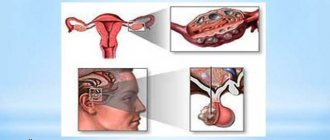MENSTRUAL CYCLE (lat. menstruus - monthly, monthly), natural cyclic changes in a woman’s body, repeated at certain intervals and externally manifested as menstruation.
And also: If the female cycle goes wrong
Changes associated with the menstrual cycle reflect the processes of reproductive function:
- egg maturation,
- her fertilization
- and implantation of the embryo into the uterine mucosa.
Menstrual function begins during puberty and continues until 45–55 years of age. A regular cycle is established immediately after menarche or over the next 1.5 - 2 years. Its duration is calculated from the first day of menstruation to the first day of the next menstruation and is characterized by a fairly wide range of individual physiological fluctuations (from 21 to 35 days, usually 28). Neurohumoral regulation of the menstrual cycle occurs with the participation
- cerebral cortex,
- hypothalamus,
- pituitary gland
- ovaries,
and
- uterus,
- vagina,
- mammary glands.
Under the influence of physiological changes in the hypothalamus and pituitary gland, cyclic changes occur in the ovaries (ovarian cycle), including follicle growth and maturation (follicular phase), ovulation and the corpus luteum phase (luteal phase).
Also: Women's problems, or Why the doctor asks you to eat more
If fertilization of the egg does not occur, the corpus luteum undergoes reverse development at the end of the menstrual cycle. Under the influence of sex hormones secreted by the ovaries, the tone, excitability and blood supply of the uterus will change, and changes will occur in its mucous membrane (uterine cycle). The uterine mucosa undergoes a number of changes during this period:
- desquamation (desquamation), manifested by actual bleeding and coinciding with the beginning of the reverse development of the corpus luteum in the ovary;
- regeneration (restoration), which begins during menstruation and usually ends by the 5th - 6th day of the cycle;
- proliferation (growth), coinciding with the process of follicle maturation;
- secretion , coinciding with the phase of development of the corpus luteum, as a result of which favorable conditions are created for the implantation and development of the embryo.
And also: Irregular menstrual cycle. If menstruation is not regular
Menstrual irregularities. Causes
The causes of menstrual irregularities may be
- severe infectious diseases,
- hypovitaminosis,
- intoxication,
- occupational, cardiovascular diseases,
- diseases of the blood, liver, kidneys,
- mental trauma,
- nervous tension,
- endocrine diseases,
- pituitary gland lesions
- inflammatory diseases of the uterus and appendages,
- damage to the uterus (for example, during induced abortion).
Menstrual cycle disorders manifest themselves in the main forms - amenorrhea and dysfunctional uterine bleeding, but can also be characterized by changes in the intensity and rhythm of menstruation:
- decreasing or increasing the intervals between them,
- increased intensity of blood secretion,
- irregular nature of menstruation.
Women with cycle disorders should be examined by a gynecologist (see Gynecology). The completeness of the menstrual cycle is based not only on the regularity of menstruation, since rhythmic menstrual-like bleeding can also be observed during an anovulatory cycle, in which there is no ovulation.
And also: Critical days: everything you wanted to ask about
The normal menstrual cycle is characterized by two phases: the presence of follicular and luteal phases in the ovary and, accordingly, phases of proliferation and secretion in the uterine mucosa. One of the methods for identifying its biphasic nature is carried out using a temperature test, based on regular morning measurement of temperature in the rectum (rectal, or basal, temperature), reflecting ovarian function. Basal temperature is below 37 °C in the follicular phase of the normal menstrual cycle, above 37 °C in the luteal phase (decreases 1 - 2 days before menstruation). During the anovulatory cycle, the basal curve is monophasic, the temperature below 37 °C is at the same level with minor fluctuations. In addition, during a cytological examination of vaginal smears from various periods of the two-phase cycle, certain dynamic changes are noted (the “pupil” symptom, the viscousness of cervical mucus, etc.). The temperature test is used with the physiological method of contraception.
And also: Several answers to the mysteries of the female menstrual cycle
Hormonal changes during the menstrual cycle affect a woman's sexual activity. Maximum sexual arousal can occur in the middle of the cycle (ovulation period) or in the days adjacent to the days of menstruation (immediately before and after it). However, the determining factor is the woman’s mental state: for example, if there is a danger of unwanted pregnancy, then maximum activity during ovulation can be completely suppressed under the influence of mental factors, while at the same time it can increase on infertile days of the cycle. However, in some cases, constant sexual abstinence in order to protect against pregnancy during ovulation, when a woman experiences a peak of excitability, can lead to a slight decrease in her libido. In this case, a combination of different contraceptives during the fertile period of the menstrual cycle is recommended. See also Inflammatory diseases of the genital organs.
How to determine ovulation
For information on how to determine ovulation using test strips, read the instructions included with them.
There are several methods by which a woman can determine approaching or occurring ovulation. The most accurate methods are:
- Ultrasound examination (ultrasound). It is performed transvaginally, transabdominally or transrectally, depending on the individual characteristics of the patient. Does not require preparation for the procedure.
- Blood analysis. Allows you to find out the level of hormones in the blood and the exact day of ovulation. Preparation involves following some recommendations and taking it on an empty stomach.
Without seeking help from specialists, a woman can independently determine ovulation in the following ways:
- Pharmacy tests for express diagnostics. They are used at home, according to the same scheme as tests to determine pregnancy. Before the procedure, you must refrain from drinking liquids and going to the toilet, do not use urine after waking up, and perform the test at least 2-3 times a day.
- Basal temperature chart. Keeping a chart allows you to determine the approach and onset of ovulation with up to 90% accuracy. The temperature should be measured at least 3 cycles in a row. Basic condition: daily measurement in the morning, rectally, without getting out of bed. The highest temperature is observed on the first day of menstruation, then it decreases and by the middle of the cycle drops sharply by 0.2-0.5 degrees. Then there is a sharp jump. Ovulation occurs on the day when the lowest temperature was recorded before the jump.
- Individual monthly calendar. With its help, you can calculate the length of the monthly cycle and ovulation occurs approximately in its middle.
During ovulation, women often note the presence of unpleasant sensations in the ovaries, their soreness, and vaginal discharge, the consistency of which resembles raw egg white. A few days before ovulation, women feel increased strength, cheerfulness, increased sexuality, and self-confidence.
https://youtu.be/NDyttT9803M
Author: Rebenok.online · Published 03/27/2017 · Updated 02/14/2019
The female
menstrual cycle is conventionally divided into several parts. Each of them is responsible for certain processes of the reproductive system. The follicular phase usually includes the first two weeks of the cycle. It is characterized by the preparation of all organs for the process of ovulation .
Terminology
Menarche - the first menstrual cycle - is a central event during puberty, indicating the female body's ability to reproduce. In humans, the average age of menarche is considered to be 12-14 years, with the norm ranging from 9 to 15 years (9 years is early menarche, the onset of menarche after 15 years is primary amenorrhea). The time of the first menstrual bleeding depends on factors such as heredity, nutrition, and general health.
The cessation of menstruation occurs at the age of 40-58 years (on average, at 47-50 years), during menopause, reproductive function declines. The timing of menopause (menopause is a period characterized by irregularity or complete cessation of menstruation) depends largely on heredity, but some diseases and medical interventions can cause early menopause.
Symptoms of menstrual irregularities in adolescents
The mother should monitor the regularity of the girl’s periods and the nature of the discharge. Single violations over 12-18 months are considered the norm. A gynecologist is contacted if the following symptoms occur:
- absence of menarche in a girl over 15 years of age;
- feeling unwell during menstruation;
- heavy bleeding;
- the interval between bleeding is more than 3 months;
- the occurrence of bleeding not related to the cycle;
- irregular cycle throughout the year;
- the appearance of acne and other rashes on the skin.
Parents should be more attentive to NMC in a girl if she:
- suffers from blood diseases;
- has a predisposition to the development of polycystic disease;
- is professionally interested in sports;
- takes strong medications;
- is underweight.
Delayed or complete absence of bleeding is called amenorrhea. This diagnosis is given to girls whose MC exceeds 35-36 days.
Follicular/menstrual phase
The menstrual phase is bleeding from the uterine cavity as a result of the shedding of the endometrial layer, which occurs at the end of the ovarian cycle if the egg has not been fertilized. The beginning of the follicular phase of the ovary or the menstrual phase of the uterus is considered to be the first day of menstruation. The duration of the follicular phase, during which the final maturation of the dominant follicle occurs, is individual for each woman: from 7 to 22 days, on average 14 days.
The follicular phase (and with it the ovarian cycle) begins with the release of GnRH by the hypothalamus, which stimulates the adenopituitary gland to secrete small amounts of follicle-stimulating and luteinizing hormones (follitropin and lutropin, respectively). A low level of estradiol secretion suppresses the secretion of follitropin and lutropin, leaving their secretion level relatively low. However, under the influence of follitropin, several follicles begin to develop in the ovaries, of which the follicle with the largest number of folliculotropin receptors and the most intensively synthesizing estradiol becomes dominant, while the rest undergo atresia. Gradually, the level of estradiol increases, but although a low concentration of estradiol suppresses the secretion of gonadotropins, a high concentration of estradiol, on the contrary, stimulates the secretion of gonadotropins, as it leads to an increase in the release of GnRH by the hypothalamus. This effect is especially noticeable for lutropin, since a high concentration of estradiol increases the sensitivity of the adenohypophysis cells that secrete lutropin to GnRH. In addition, follicles react more strongly to lutropin due to a larger number of receptors for this hormone. Thus, in this case, regulation takes place according to the principle of positive feedback. So, the follicle increases in size until there is a sharp release of lutropin from the adenohypophysis. This is where the follicular phase ends and the ovulatory phase begins.
Ovulation and luteinization
Ovulation and luteinization of granulosa cells of the follicle are caused by luteinizing hormone. As a result, the follicle cells secrete progesterone.
Finished works on a similar topic
- Course work Ovarian cycle and ovulation 440 rub.
- Abstract Ovarian cycle and ovulation 260 rub.
- Test work Ovarian cycle and ovulation 210 rub.
Receive completed work or specialist advice on your educational project Find out the cost
In the second half of the cycle, estradiol and progesterone act on the hypothalamus and suppress the secretion of FSH and LH, affecting the higher parts of the central nervous system.
Sexual desire depends on the stage of the cycle.
Definition 2
Luteinization is the process of production and release of large amounts of progesterone by granulosa cells of the follicle under the influence of luteinizing hormone.
Luteinization leads to the transformation of the ruptured follicle into the corpus luteum.
Progesterone causes an increase in basal body temperature - a thermogenic effect - through the influence of progesterone on the hypothalamic centers located in the hypothalamus.
The corpus luteum exists for about 14 days. By the end of this period, the secretion of progesterone decreases, the process of luteolysis begins, during which the basal body temperature decreases to the preovulatory level.
Ovulatory phase
Around the seventh day of the cycle, a dominant follicle is determined, which continues to grow and secretes increasing amounts of estradiol, while the remaining follicles undergo reverse development. A follicle that has reached maturity and is capable of ovulation is called a Graafian vesicle. During the ovulatory phase, which lasts about three days, luteinizing hormone (LH) is released. Within 36-48 hours, several waves of LH release occur, and its plasma concentration increases significantly. The release of LH completes the development of the follicle, stimulates the production of prostaglandins and proteolytic enzymes necessary for rupture of the follicle wall and release of a mature egg (ovulation itself). At the same time, the level of estradiol decreases, which is sometimes accompanied by ovulatory syndrome. Ovulation usually occurs within 24 hours after the largest LH surge (16 to 48 hours). During ovulation, 5-10 ml of follicular fluid is released, which contains the egg.
FSH is elevated in the follicular phase - what does this phenomenon mean for the body?
Since there are many reasons why FSH levels decrease or increase, it is not possible to make a diagnosis and cure on your own. Only the doctor will explain why this happens after receiving the test results. In addition, you cannot do without the help of a gynecologist and endocrinologist. To decipher the analysis, it is better to contact a specialist.
High FSH levels may indicate the following health problems:
- Presence of ovarian wasting syndrome;
- Pathological condition of the pituitary gland, the presence of a tumor;
- The activity of hereditary or genetic diseases, in particular this concerns Shereshevsky-Turner syndrome and Swyer syndrome;
- Not tearing the follicle;
- Presence of endometrioid ovarian cyst;
- Development of a hormone-producing tumor;
- Radioactive exposure, negative consequences of radiotherapy;
- Smoking for a long period;
- Kidney failure;
- Self-treatment with medications of a certain group.
How to treat increased FSH in the follicular phase? First, you should contact a gynecologist, who will determine the cause of this phenomenon and, in accordance with it, prescribe etiotropic treatment.
The ratio of LH and FSH. If LH is higher than FSH in the follicular phase, the forum will help you figure out what this affects:
- Sheehan syndrome may develop;
- The development of hypogonadism due to insufficient production of the hormone by the pituitary gland and hypothalamus;
- The risk of obesity increases.
A decrease in the concentration of this hormone can occur for the following reasons:
- After surgery; Poor nutrition; Chronic intoxication of the body; Excessive secretion of prolactin; Taking anabolic steroids and valproic acid drugs.
Luteal/secretory phase
The period of time between ovulation and the onset of menstrual bleeding is called the luteal phase of the cycle (also known as the corpus luteum phase). Unlike the follicular phase, the duration of the luteal phase is more constant - 13-14 days (± 2 days). After the Graafian vesicle ruptures, its walls collapse, its cells accumulate lipids and luteal pigment, this gives it a yellow color. The transformed Graafian follicle is now called the corpus luteum. The duration of the luteal phase depends on the period of functioning (10-12 days) of the corpus luteum, during which time the corpus luteum secretes progesterone, estradiol and androgens. Elevated levels of estrogen and progesterone change the characteristics of the two outer layers of the endometrium. The endometrial glands mature, proliferate and begin to secrete (secretory phase), the uterus prepares for implantation of a fertilized egg. Progesterone and estrogen levels peak in the mid-luteal phase, and LH and FSH levels decrease in response.
When pregnancy occurs, the corpus luteum begins to produce progesterone until the placenta develops and secretes estrogen and progesterone.
If pregnancy does not occur, the corpus luteum stops functioning, the level of estrogen and progesterone decreases, which leads to swelling and necrotic changes in the endometrium. A decrease in progesterone levels also increases the synthesis of prostaglandins. If the egg is not fertilized, then after some time the corpus luteum undergoes luteolysis, that is, lysis or structural destruction, and is no longer able to synthesize progesterone and estradiol. The regulator of luteolysis is the prostaglandin PGF2-[en]. Due to luteolysis, the secretion of follitropin and lutropin is no longer suppressed, since there is no longer a negative feedback, and the secretion of these hormones begins to increase, stimulating the development of a new follicle. A decrease in the level of estrogen and progesterone also contributes to the resumption of the synthesis of LH and FSH, and a new menstrual cycle begins.
What you need to know about the follicular phase
“During the follicular phase of the cycle, that is, immediately after menstruation, the body, thanks to follicle-stimulating hormone (FSH), begins to grow 10-20 follicle cells. One of them becomes dominant, the rest are eliminated from the body through the lymphatic fluid, and ovulation occurs. While these cells grow, a hormone that is magical for girls is produced - estrogen. During this phase of the cycle, you notice a surge of energy, fluid outflow, and a wonderful mood. This is the period when we lose weight faster, and exercise becomes much more effective,” says obstetrician-gynecologist Ekaterina Kovaleva, Woman Code expert.
“In order to help the body, I recommend adding foods rich in iron and vitamin C to the diet in the first phase of the cycle. The fact is that due to menstruation, the body is in a state of iron loss, and this deficiency must be replenished. Since iron is absorbed better with vitamin C, it is also necessary during this period. Pay attention to apples, meat, spinach, broccoli, pomegranate juice, as well as foods that are phytoestrogens - dried cranberries, flax seeds, legumes, any seeds and nuts, prunes, dried apricots.”









